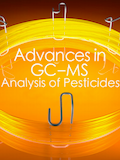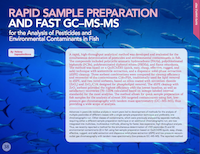Rapid Sample Preparation and Fast GC–MS-MS for the Analysis of Pesticides and Environmental Contaminants in Fish
Spectroscopy E-Books
A rapid, high-throughput analytical method was developed and evaluated for the simultaneous determination of pesticides and environmental contaminants in fish. The compounds included polycyclic aromatic hydrocarbons (PAHs), polychlorinated biphenyls (PCBs), polybrominated diphenyl ethers (PBDEs), and flame retardants. The method was based on a QuEChERS (quick, easy, cheap, effective, rugged, and safe) technique with acetonitrile extraction, and a dispersive solid-phase extraction (dSPE) cleanup. Three sorbent combinations were compared for cleanup efficiency and recoveries of the contaminants: C18+PSA, traditionally used for lipid removal in dSPE, and two novel sorbents, based on silica coated with zirconium dioxide (ZrO2 ) and ZrO2 /C18, designed for phospholipid removal. The dSPE cleanup with ZrO2 sorbent provided the highest efficiency with the lowest baseline, as well as satisfactory recoveries (70–120% calculated based on isotope-labeled internal standards) for the most analytes. The method allows for quick sample preparation of fish samples for the analysis of almost 200 targeted contaminants using fast, lowpressure gas chromatography with tandem mass spectrometry (GC–MS-MS), thus providing a wide scope of analysis.
Read more here.

Best of the Week: AI and IoT for Pollution Monitoring, High Speed Laser MS
April 25th 2025Top articles published this week include a preview of our upcoming content series for National Space Day, a news story about air quality monitoring, and an announcement from Metrohm about their new Midwest office.
LIBS Illuminates the Hidden Health Risks of Indoor Welding and Soldering
April 23rd 2025A new dual-spectroscopy approach reveals real-time pollution threats in indoor workspaces. Chinese researchers have pioneered the use of laser-induced breakdown spectroscopy (LIBS) and aerosol mass spectrometry to uncover and monitor harmful heavy metal and dust emissions from soldering and welding in real-time. These complementary tools offer a fast, accurate means to evaluate air quality threats in industrial and indoor environments—where people spend most of their time.
